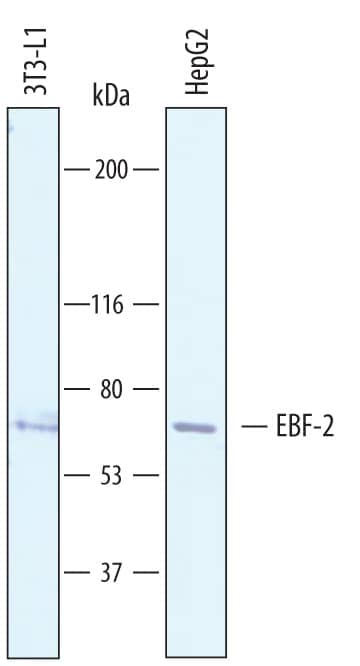Human/Mouse EBF-2 Antibody
R&D Systems, part of Bio-Techne | Catalog # AF7006

Key Product Details
Species Reactivity
Validated:
Cited:
Applications
Validated:
Cited:
Label
Antibody Source
Product Specifications
Immunogen
Arg407-Ser519
Accession # O08792
Specificity
Clonality
Host
Isotype
Scientific Data Images for Human/Mouse EBF-2 Antibody
Detection of Human and Mouse EBF-2 by Western Blot.
Western blot shows lysates of 3T3-L1 mouse embryonic fibroblast adipose-like cell line and HepG2 human hepatocellular carcinoma cell line. PVDF membrane was probed with 1 µg/mL of Sheep Anti-Human/Mouse EBF-2 Antigen Affinity-purified Polyclonal Antibody (Catalog # AF7006) followed by HRP-conjugated Anti-Sheep IgG Secondary Antibody (HAF016). A specific band was detected for EBF-2 at approximately 65 kDa (as indicated). This experiment was conducted under reducing conditions and using Immunoblot Buffer Group 8.EBF-2 in Mouse Embryo.
EBF-2 was detected in immersion fixed frozen sections of mouse embryo (15 d.p.c.) using Sheep Anti-Mouse EBF-2 Antigen Affinity-purified Polyclonal Antibody (Catalog # AF7006) at 10 µg/mL overnight at 4 °C. Tissue was stained using the Anti-Sheep HRP-DAB Cell & Tissue Staining Kit (brown; CTS019) and counterstained with hematoxylin (blue). Specific staining was localized to developing muscle cells. View our protocol for Chromogenic IHC Staining of Frozen Tissue Sections.Applications for Human/Mouse EBF-2 Antibody
Immunohistochemistry
Sample: Immersion fixed frozen sections of mouse embryo (15 d.p.c.)
Western Blot
Sample: 3T3‑L1 mouse embryonic fibroblast adipose-like cell line and HepG2 human hepatocellular carcinoma cell line
Reviewed Applications
Read 1 review rated 5 using AF7006 in the following applications:
Formulation, Preparation, and Storage
Purification
Reconstitution
Formulation
Shipping
Stability & Storage
- 12 months from date of receipt, -20 to -70 °C as supplied.
- 1 month, 2 to 8 °C under sterile conditions after reconstitution.
- 6 months, -20 to -70 °C under sterile conditions after reconstitution.
Background: EBF-2
EBF-2 (Early B cell Factor 2; also Mmot1, OLF3 and COE2) is a 62 kDa (predicted) member of the COE family of transcription factors. It is expressed in immature osteoblasts and Purkinje cells, and in the embryo is associated with the migration of postmitotic neuroblasts. In immature osteoblasts, EBF-2 appears to upregulate OPG, suppressing osteoclast formation. And in the developing retina, EBF-2 is found in ganglion, glycinergic Amacrine and horizontal cells, possibly promoting their development over that of photoreceptor cells. Mouse EBF-2 is 575 amino acids (aa) in length. It contains one DNA-binding region with an embedded C5-type zinc‑finger motif (aa 62-238), a dimerization ITP/TIG domain (aa 253-336), and a Pro/Ser-rich transactivation domain (aa 453-534). Although considered an HLH type transcription factor, it does not contain the typical "b", or basic amino acid sequence associated with bHLH factors. EBF-2 both homodimerizes, and heterodimerizes with EBF-1 and -3. There is an alternative start site at Met23. Over aa 407-519, mouse EBF-2 is identical in aa sequence to rat EBF-2 and shares 99% aa identity with human EBF-2.
Long Name
Alternate Names
Gene Symbol
UniProt
Additional EBF-2 Products
Product Documents for Human/Mouse EBF-2 Antibody
Product Specific Notices for Human/Mouse EBF-2 Antibody
For research use only

